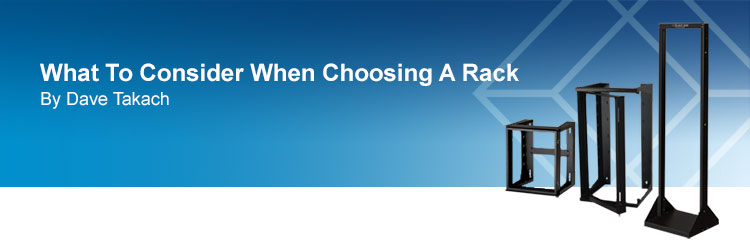Sign in

Please check your email address and password.
Navigation |

What To Consider When Choosing A RackIf you need frequent access to all sides of the equipment and cabling, an open rack is more convenient than a cabinet. If your equipment needs ventilation, racks offer more air circulation than cabinets. With the open design, racks are a good choice in areas where security isn’t a concern, or inside data centres and closets with locked doors. Types of RacksIf you’re installing patch panels, a two-post rack with some cable management is the right choice. But if you have a mix of networking Equipment, servers, and patch panels, then a 4-post rack makes more sense because it provides more stable, 4-point mounting for deep equipment. Rack HeightsHeight, or rack units, is one of the most important specifications in choosing a rack. One rack unit (1U) is 1.75" of usable space. Most freestanding racks come in a standard 45U height, so they fit rooms with standard ceilings. Wall Mount RacksWall mount-style racks save floor space. They’re very convenient for installing in cramped wiring closets or narrow hallways. Some even swing out for easy equipment installation and cable connections. Other low-profile racks enable you to flush mount equipment vertically against a wall to further reduce the amount of space they take up. Wall mount racks typically require a solid or reinforced wall. To determine which wall rack is best for your application, measure the deepest piece of equipment and cable(s) out of the back end to be sure they will fit. Then verify the weight capacity needed. Cable ManagementMany racks have built-in cable management troughs and cable rings for routing cable. If your rack doesn’t have these, consider adding managers for neatly routing cable. Vertical managers are great for organising cable runs top to bottom. Horizontal managers are designed to guide cables and hold them precisely at the same level as mounted equipment. You can also add inexpensive hook-and-loop cable ties to hold and bundle cable securely. The ExtrasConsider shelving for your rack. The type you choose depends on the equipment you plan to mount. You can choose from solid or vented shelves, stationary or pull-out shelves. There are shelves built to hold specific pieces of equipment such as servers, monitors, and keyboards. You can place small devices on a cantilevered shelf. Larger, heavier items, such as monitors, should be put on a centre-weight shelf. There are even panels designed to hold flat-screen monitors. Featured Products |